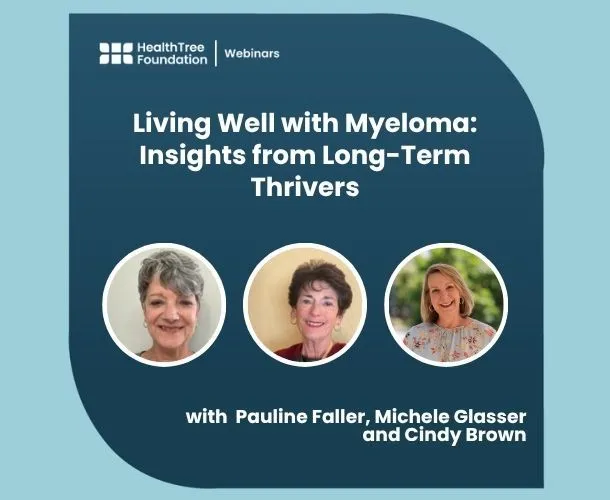Minimal Residual Disease in Multiple Myeloma

BY JIM OMEL, MD Much has been written about MRD (Minimal Residual Disease) in multiple myeloma. MRD is certainly in the news and will be even more so in the future. Treatment of multiple myeloma has improved tremendously in the last few years. Essentially every patient responds to treatment, but at differing depths of response and durability. Complete clearing of m-protein results in CR (Complete Response). CR plus normalization of free light chain numbers gives an even better response criterion called sCR (stringent Complete Response). Given the high rates of complete responses seen in patients with multiple myeloma, it is necessary to develop new categories which are deeper than those conventionally defined as complete response. Our novel therapies now take many patients well beyond even sCR to a point where myeloma cells can barely be seen (MRD positive) or not found at all by our best detection methods (MRD negative). Patients who achieve MRD negative status have a better prognosis than those who don’t. Obviously we would prefer that everyone achieve MRD negative levels, but the decision to try and reach this point is not easy. Every treatment has toxicity costs. Barely detectable disease (MRD positive) is still a remarkable response, and signifies good myeloma control. The few myeloma cells present could represent a return to a MGUS state, and the immune system might be quite able to keep the disease under control. MRD determination (negative or positive) at very low levels is a valuable tool which we need to learn how to best use. Can it be used as a determinant to change therapy (if still pos), or to stop maintenance therapy (if neg)? If it is consistently neg for an extended time (1 year? 3 years? 5 years?) and imaging shows no active lesions, can we use it to declare total cure from myeloma? We can’t use MRD positivity or negativity to guide therapy right now because we just don’t know those answers. However assessment of MRD in response to therapy has already shown usefulness because longer progression-free survival (PFS) is seen consistently among patients who have achieved MRD negativity. On the NCI Myeloma Steering Committee we strongly favor clinical trial designs going forward which include MRD neg measurement as a primary or secondary endpoint. Eventually we will know the actual predictive basis of this disease biomarker. It might become so reliable that FDA will accept MRD neg results as a basis for drug approval, thus negating the long times needed to see PFS (progression free survival) and very long times (thankfully!) for OS (overall survival). A respected group of FDA and NCI officials, industry representatives, myeloma clinicians from several countries, and others have been developing a formal ‘white paper’ explaining how to evaluate and use MRD testing. The work is essentially finished and our next step is publication. It should serve as a basis for further understanding and use of this deep measure of myeloma response.
BY JIM OMEL, MD Much has been written about MRD (Minimal Residual Disease) in multiple myeloma. MRD is certainly in the news and will be even more so in the future. Treatment of multiple myeloma has improved tremendously in the last few years. Essentially every patient responds to treatment, but at differing depths of response and durability. Complete clearing of m-protein results in CR (Complete Response). CR plus normalization of free light chain numbers gives an even better response criterion called sCR (stringent Complete Response). Given the high rates of complete responses seen in patients with multiple myeloma, it is necessary to develop new categories which are deeper than those conventionally defined as complete response. Our novel therapies now take many patients well beyond even sCR to a point where myeloma cells can barely be seen (MRD positive) or not found at all by our best detection methods (MRD negative). Patients who achieve MRD negative status have a better prognosis than those who don’t. Obviously we would prefer that everyone achieve MRD negative levels, but the decision to try and reach this point is not easy. Every treatment has toxicity costs. Barely detectable disease (MRD positive) is still a remarkable response, and signifies good myeloma control. The few myeloma cells present could represent a return to a MGUS state, and the immune system might be quite able to keep the disease under control. MRD determination (negative or positive) at very low levels is a valuable tool which we need to learn how to best use. Can it be used as a determinant to change therapy (if still pos), or to stop maintenance therapy (if neg)? If it is consistently neg for an extended time (1 year? 3 years? 5 years?) and imaging shows no active lesions, can we use it to declare total cure from myeloma? We can’t use MRD positivity or negativity to guide therapy right now because we just don’t know those answers. However assessment of MRD in response to therapy has already shown usefulness because longer progression-free survival (PFS) is seen consistently among patients who have achieved MRD negativity. On the NCI Myeloma Steering Committee we strongly favor clinical trial designs going forward which include MRD neg measurement as a primary or secondary endpoint. Eventually we will know the actual predictive basis of this disease biomarker. It might become so reliable that FDA will accept MRD neg results as a basis for drug approval, thus negating the long times needed to see PFS (progression free survival) and very long times (thankfully!) for OS (overall survival). A respected group of FDA and NCI officials, industry representatives, myeloma clinicians from several countries, and others have been developing a formal ‘white paper’ explaining how to evaluate and use MRD testing. The work is essentially finished and our next step is publication. It should serve as a basis for further understanding and use of this deep measure of myeloma response.
about the author
Jennifer Ahlstrom
Myeloma survivor, patient advocate, wife, mom of 6. Believer that patients can contribute to cures by joining HealthTree Cure Hub and joining clinical research. Founder and CEO of HealthTree Foundation.
More on Navigating Your Health
Trending Articles




Get the Latest Multiple Myeloma Updates, Delivered to You.
By subscribing to the HealthTree newsletter, you'll receive the latest research, treatment updates, and expert insights to help you navigate your health.
Together we care.
Together we cure.
3x Faster.













